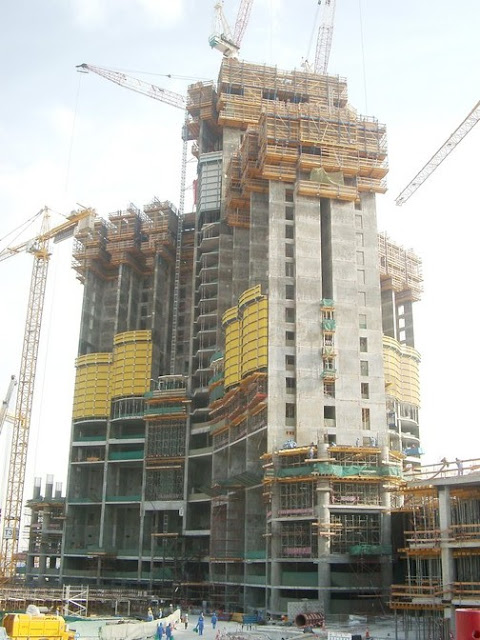 Burj Khalifa
Burj KhalifaBUILDING A GLOBAL ICON
the tower was constructed by a South Korean company, Samsung Engineering & Construction, which also did work on the Petronas Twin Towers and Taipei 101. Samsung Engineering & Construction is building the tower in a joint venture with Besix from Belgium and Arabtec from UAE. Turner is the Project Manager on the main construction contract.
The primary structural system of Burj Khalifa is reinforced concrete. Over 45,000 m3 (58,900 cu yd) of concrete, weighing more than 110,000 tonnes (120,000 ST; 110,000 LT) were used to construct the concrete and steel foundation, which features 192 piles, with each pile is 1.5 metre diameter x 43 metre long buried more than 50 m (164 ft) deep. Burj Khalifa's construction used 330,000 m3 (431,600 cu yd) of concrete and 55,000 tonnes of steel rebar, and construction took 22 million man-hours. A high density, low permeability concrete was used in the foundations of Burj Khalifa. A cathodic protection system under the mat is used to minimize any detrimental effects from corrosive chemicals in local ground water.
The previous record for pumping concrete on any project was set during the extension of the Riva del Garda Hydroelectric Power Plant in Italy in 1994, when concrete was pumped to a height of 532 m (1,745 ft). Burj Khalifa exceeded this height on 19 August 2007, and as of May 2008 concrete was pumped to a delivery height of 606 m (1,988 ft), the 156th floor. The remaining structure above is built of lighter steel.
Burj Khalifa is highly compartmentalised. Pressurized, air-conditioned refuge floors are located approximately every 35 floors where people can shelter on their long walk down to safety in case of an emergency or fire.
Special mixes of concrete are made to withstand the extreme pressures of the massive building weight; as is typical with reinforced concrete construction, each batch of concrete used was tested to ensure it could withstand certain pressures.
The consistency of the concrete used in the project was essential. It was difficult to create a concrete that could withstand both the thousands of tonnes bearing down on it and Persian Gulf temperatures that can reach 50 °C (122 °F). To combat this problem, the concrete was not poured during the day. Instead, during the summer months ice was added to the mixture and it was poured at night when the air is cooler and the humidity is higher. A cooler concrete mixture cures evenly throughout and is therefore less likely to set too quickly and crack. Any significant cracks could have put the entire project in jeopardy.
The unique design and engineering challenges of building Burj Khalifa have been featured in a number of television documentaries, including the Big, Bigger, Biggest series on the National Geographic and Five channels, and the Mega Builders series on the Discovery Channel.

No comments:
Post a Comment